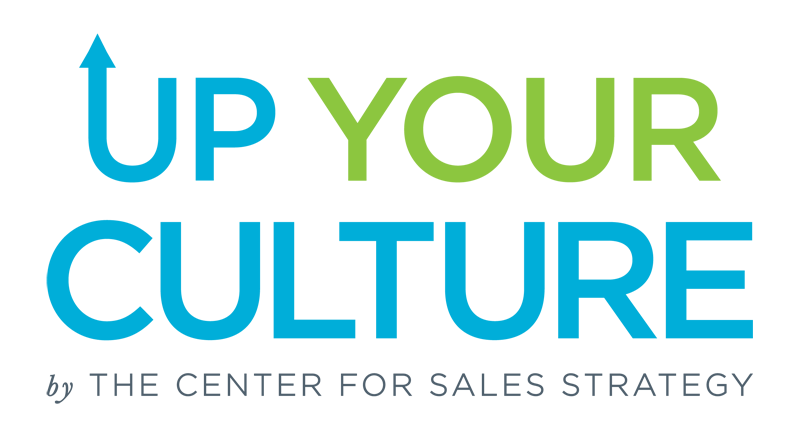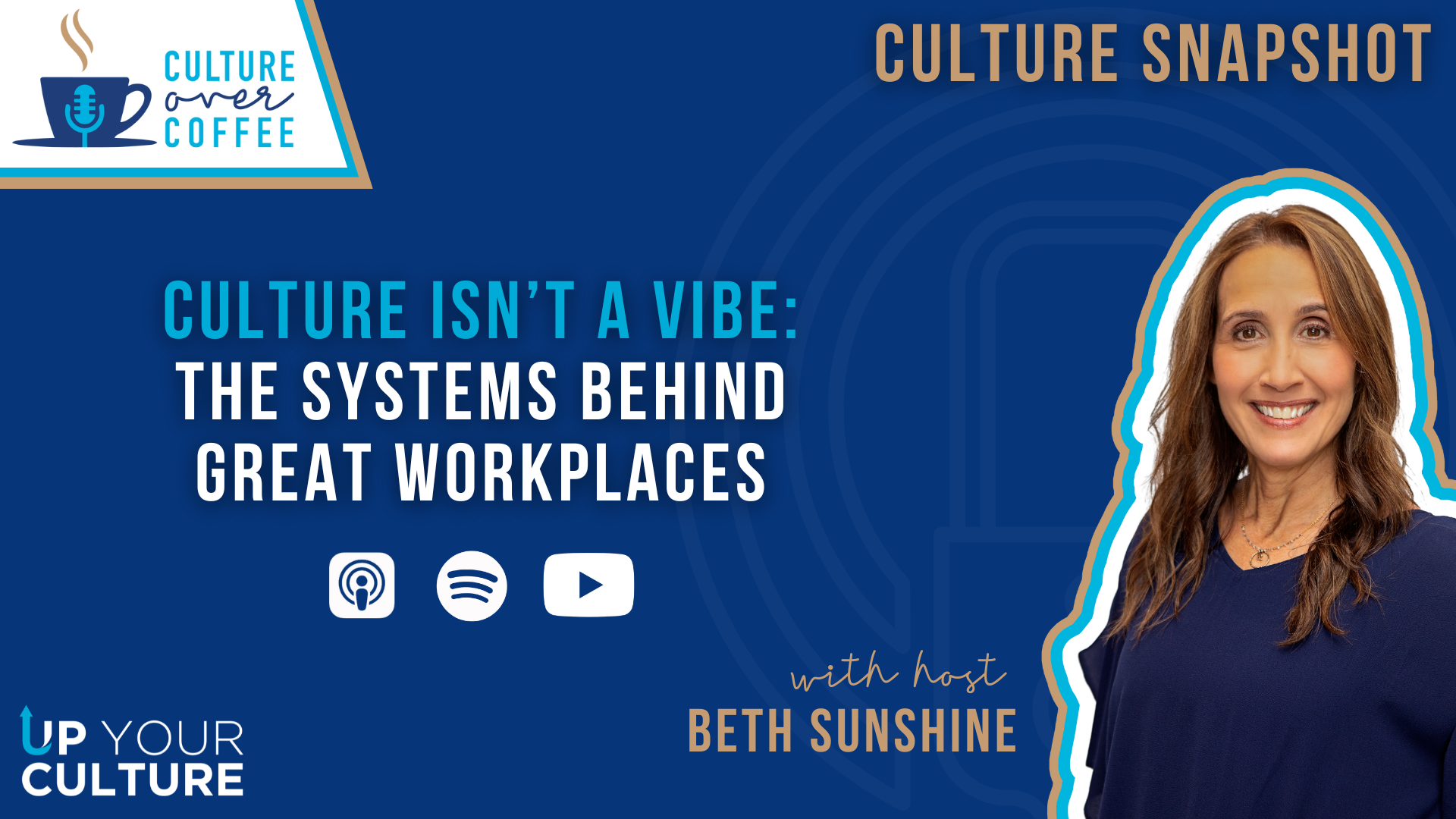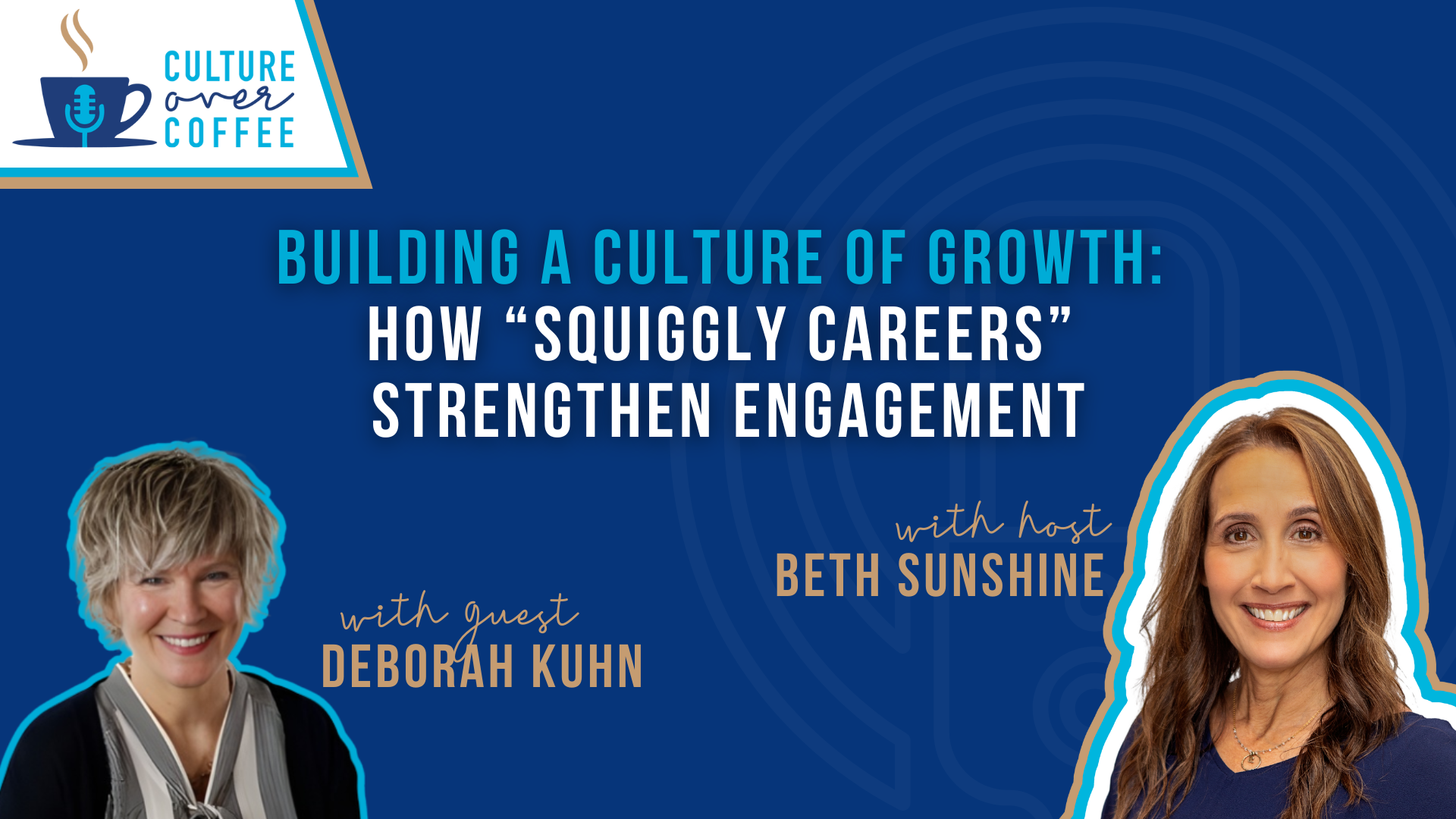
In this episode, we’re looking at How and Where We Work in light of the recent findings from our latest company culture and employee engagement report, ENGAGE 2023.
In this section of the report, we asked how employees, managers, and company leaders are continuing to adapt to hybrid and remote work models.
Helping Beth explore how people are feeling about this new world of work is Matt Sunshine, CEO of The Center for Sales Strategy.
Matt brings some great insights to light, like:
- How company leaders who fail to clearly define the rules of a new work model leave employees feeling anxious and frustrated
- Why hybrid and remote work allows companies to hire the very best people
- And, lastly, why encouraging people to return to the office should only result in asking the question, “What problem would that solve?”
Don’t Leave Gray Areas in Hybrid/Remote Work
“As you know, this season, we are digging into our annual culture report, ENGAGE 2023,” Beth says. “We're discussing all of the stories that the data tells. And today, I'm especially excited because we are focusing on a very hot topic, something I know you talk about, and that is work models.
“I know you find yourself talking about this with clients all the time. I'm especially anxious to get your perspective on these findings. So,let me start by asking you, were there any stats or findings that just really jumped off the page to you?”
Matt says, “Actually, I don't think that there was anything that was shocking to me. I don't think it'll be shocking to anyone that's paying attention, but I think it reinforces what many have probably observed.
“For example...86% of those surveyed prefer hybrid or remote work. 86%! We're not kidding around. I mean, they really want hybrid work!”
“That jumped out to me, too,” Beth says. “We will get into that.
“First, though, it's clear to me after reading this that companies are continuing to adapt to the new world of work. The survey showed that one out of every four people now reports to an office every day. That's not a lot.
“45% work in a hybrid model, and 30% work fully remote, and that’s just today. You know, who knows what tomorrow will bring? But a big switch from years past.
“So, how are the company leaders that you work with regularly? How are they dealing with these changes?”
“All sorts of ways,” Matt says. “Sadly, a lot of them are not dealing with it. And I think that's the biggest cause of concern from my point of view.
“So, in real life, this is what happens. A leader in an organization says, ‘You know what? I think this is the way we should do it around here, but I'm not going to mandate that. I'm going to let everybody just do what they think is right.’
“That sort of ‘grayness’ is actually causing more anxiety than anything else.
“I mean, the leaders that I'm talking to just wish the company would just give them a policy and just say, ‘Hey, this is what we're doing. We're in Tuesday, Wednesday, Thursday, or we're in Monday through Friday, or we're in Monday through Wednesday, whatever.’ Just simply tell us what the rules are and then we can decide.
“But leaving it gray leaves a lot of people frustrated and causes more anxiety than it probably needs to have.
“And, what do I see the most of? I see hybrid. And what I'm seeing the most of [schedule-wise] is either three days a week in the office and two days not or four days in and one day not. And that one day typically is a Friday. That's becoming the norm.”
“I'm glad you mentioned that about the anxiety that ‘grayness’ causes,” Beth says. “Because I think a lot of company leaders do that because they have the best intentions, and yet it backfires.”
When Recruiting in an Increasingly Hybrid/Remote World, “Sell Your Strengths”
“Okay,” Beth says. “Let's get into that stat you said really jumped off the page. I was also fascinated to find that roughly 86% of those surveyed want to work either hybrid or fully remote.
“Only 5% of employees and 15% of managers prefer in-office work.
“It's clear how important it will be for companies to keep that in mind when they're recruiting when they're trying to attract new employees. That's going to play a big role in what they're doing. So, are you finding that work models are affecting recruitment in the companies that you work with?”
“Sure,” Matt says. “But no more than they ever have.
“I think that's always been a really big deal. Not only where you work but how often you work.
“Does the day start at 7:30 and end at 4:30? Does the day start at 8:30 and go to 5? Do you have flexibility depending on if you have kids or not have kids? Are some folks allowed to get in at 7, work 7 to 4, and others are able to work 9 to 6?
“I think all of those things have always been really important decisions. Same with where the office is located.
“You know, for some people, if you're two, three miles away from your office, maybe you live in an apartment, maybe the ability to go into the office is exactly what you need because you don't have enough room in your apartment to work remotely.
“But if you live 30 miles away, and there's traffic, and it's going to take you 90 minutes to get to the office, you might have a completely different point of view.
“Also, the quality of the office. I mean, it wasn't that long ago that with offices, there was an appeal, right? ‘Oh, my office is so great, it has this and this, and it's located next to great restaurants, and we're able to do this after work.’ Right?
“So, I think all of those things absolutely matter. They matter a lot today. I think people are weighing those when they're making a decision about where they want to work. They're weighing all of it, not just a little bit of it, but all of it.”
“That makes perfect sense,” Beth says. “So, what would you recommend to leaders today, knowing they're trying to attract a workforce that largely prefers hybrid and remote work?”
“To me,” Matt says. “The question of getting people to come into the office is: what do they need to come into the office for? What is that reason?
“If the only reason why people come into the office is so that you can do a ‘bed check,’ then that's ridiculous.
“We run a company here that's not a remote workforce but a work-from-home workforce, which is very different, right? We are, we are work-from-anywhere actually. These are all different versions of remote.
“We stress that as a big advantage for us. So, what I say to companies is: one of the benefits is you don't have to just recruit the best person that lives within 20 miles of your building. You can just recruit the very best person that you can find. That's a big advantage.
“But I think what I would recommend to leaders is that they should sell their strengths. They should sell what they're doing.
“And if you want to stress the fact that you bring everyone together and there's this great collaboration and sense of team and that’s the way you do it, then you should stress that. You should make a big deal about that.”
“I love that,” Beth says. “And for those that have required their people to all come into the office, knowing that only 5% of employees and 15% of managers want that.
“I like where you started too. You need to have a reason. There needs to be something there that makes that worth the commute for those who that isn't their preference. Interesting take.”
Don’t Force People to Do the Same Work In-Office That They Could Do at Home
“One thing that has become really clear to me over the years is that determining you're going to use a hybrid model is only step one for company leaders,” Beth says. “They decide ‘we're going to allow for hybrid, but then we need to define what that looks like.’ And that can actually be the more challenging part in my experience, because it can look different for everyone.
“Now, most people who are currently working outside of the office for at least part of the week, based on our survey results, they believe that the ideal work model includes only one day a week in the office.
“81% of those surveyed insists that no more than two days should be spent in the office. And I know that's not what every hybrid work model looks like. So, what are your general thoughts on this?”
“I would think that the majority of those people don't see any value of being in the office,” Matt says. “Right? That's really what they're saying is, ‘I don't see value in being there.’
“And I think to really understand that, you need to think about why is it that we used to go to the office? What was it about the office that made us do that and want to do that?
“It was a few things. Number one: it's where you went to get information. There was no other way to get information besides going to the office. I mean you go back, you know, 25 years or so, people were not even using email the way they used it today. We didn't have cell phones or smartphones.
“The other thing is in order to get collateral material that you need. So, I'll take it from my point of view, which is the sales arena and the revenue production arena of businesses. In order for a salesperson or a sales leader to get their pricing or to get the collateral material that they needed to present their company, that was all held at the building right at the mothership.
“You had to go it. The collateral material was usually on a wall with lots of racks. And you'd grab what you needed, you'd pull out what you needed. There was the inventory analysis, the pricing analysis, etc. All of that took place at the office. So, you needed that.
“Today, we don't need that. All of that is available on your phone or on your computer.
“So, people are not seeing the value of going into the office anymore. If there was value to going into the office, I think people would go. I think people would say, ‘You know what, that makes sense. I need, to have ‘that,’ so I'm gladly going there.
“But to make people come in simply so they can sit at a desk and do their work the exact same way they would sit at a desk at home?
“Here's what's really happening. You make me go into the office and when I go, no one else is there. I walk in, and it's a ghost town. The office is built for 30 or 40, or 50 people, and there are three people in there because not everyone has the same days that they're working hybrid or not the same times that they're working.
“So, now you've upset me. I drove 45 minutes to get to the office. You know, I hook up, I'm sitting at my desk, no one else is here. There's none of this collaboration that's supposed to happen.
“I think that's the problem. And if managers want collaboration, and they say it’s really important. Then get everyone together at the same time and make there be collaboration.”
Make Your Virtual Meetings More Collaborative
“Beyond the day-to-day work model, let's talk about how people are meeting these days,” Beth says. “One of the most interesting changes in this data from last year, and my perspective, involves the preference for in-person meetings.
“This year, 71% reported leaving those in-person meetings feeling more engaged than they were if it was a Zoom meeting, if it was virtual. But that's dropped since last year. That number was 80%. So first, why do you think that number has dropped so much?
“Because the pendulum swings back and forth,” Matt says. “In April of 2020, when everyone started staying home, everyone reached out and said, ‘Oh my goodness, what are we going to do? People hate being on video, and they hate doing this, and they want to come into the office, and they're mad that they can't come into the office.’
“And I remember saying to everyone, ‘It's okay. They'll figure it out. You'll see six months from now; everyone will love doing these virtual meetings. Everyone will love it. They'll have so much time back, they're going to love it.’
“Sure enough, that's what happened, right? The pendulum swung, and everyone's like, I don't want to go into the office. I like doing virtually. I can do it all. And now the pendulum's swinging back the other way on that.
“Even with the drop-off,” Beth says, “The vast majority of people still feel more engaged by in-person meetings. So, that makes sense. What would you recommend that company leaders do to make virtual meetings more energizing? So that they have that same kind of uplift from, from a zoom meeting?
“So, I just watched a video this morning that was interesting. It was on the cost of meetings, right? And one company's point of view was, ‘we should get rid of meetings because they cost too much money.’ And most meetings are just bullet points of things that you're telling people versus questions, things that you're discussing.
“And another company's point of view was, ‘no, you should still do meetings; you should just make them better.’
“I think I actually like both of those statements. I think we should get rid of meetings that are more just talking at people and we should have more meetings where we are doing them better. So a couple of tips to make those virtual meetings better. Is that really what you want?
“Make them more collaborative versus just updating people on things, right? There are times when you need to update people. A town hall is a great example of updating people on everything, but you should also do Q and A and let people have some input.
“Number one is to be collaborative.
“I'd also say this: as the leader, don't do all the talking. Think of yourself as the host of the show, not the star of the show. You're the host of the show. Let others be the star of the show.
“The third thing is, just because you set a meeting for one hour does not mean the meeting needs to take an hour. If the meeting is really only a 15-minute meeting, there's nothing wrong with a 15-minute meeting. They don't all have to be 30 minute or one-hour meetings.
“I would just focus on making your meetings better.
“And there’s a quick icebreaker that we learned, that I'll put out there. I didn't invent this one, but I am going to use it. When you start your virtual meeting, just have everyone share what they're currently wearing on their feet.”
Ask Yourself: “What Problem Will Be Solved by Getting Everyone Back In-Office?”
“Last question for you,” Beth says. “If you could recommend only one thing for company leaders to do when it comes to identifying and using the optimal work model for their organization, what would it be?”
Matt says, “I would focus more on answering the question of ‘what is it that we want to accomplish?’
“What is it that we want to be known for? Start there versus, ‘What can we do to get everyone back in the office?’
“That's the mistake that I hear too often is leaders say, ‘Okay, we need to have a meeting to discuss what we can do to get everyone to come back in the office.’
“And when I'm a part of that, I usually stop everybody and say, ‘hey, before we talk about how we can get them all to come to come into the office, can we have a conversation of what is it that we're trying to accomplish by getting them all to come into the office? What problem will getting everyone back into the office solve?’
“I think if you approach it that way, you'll get better outcomes.”












Leave a Comment